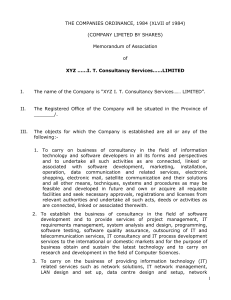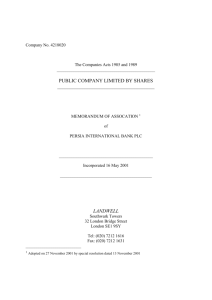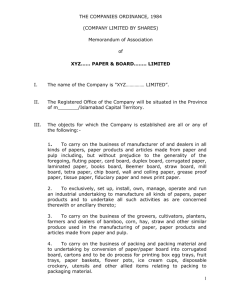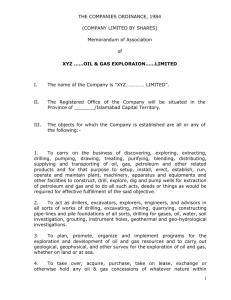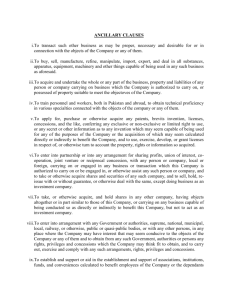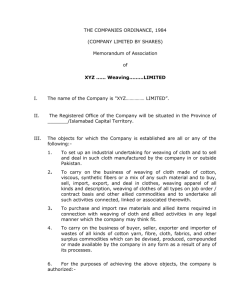1st Quarter 2014 MD&A
advertisement
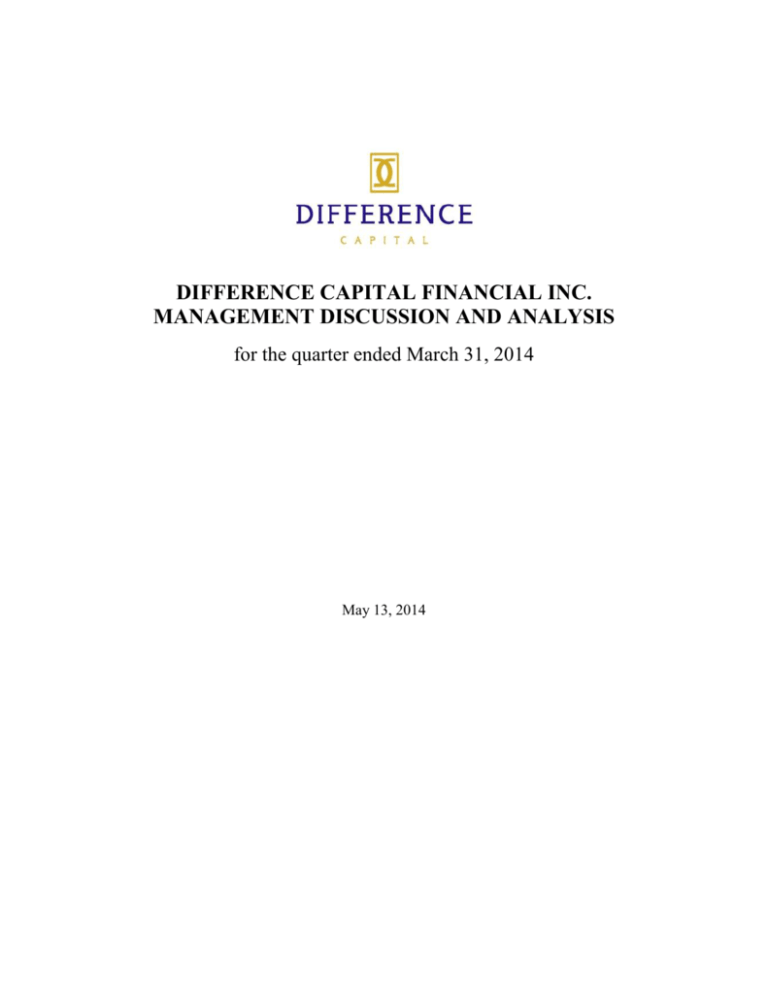
DIFFERENCE CAPITAL FINANCIAL INC. MANAGEMENT DISCUSSION AND ANALYSIS for the quarter ended March 31, 2014 May 13, 2014 TABLE OF CONTENTS INTERNATIONAL FINANCIAL REPORTING STANDARDS................................................................... 1 FORWARD-LOOKING STATEMENTS ................................................................................................ 1 NOTE REGARDING NON-IFRS FINANCIAL MEASURES ..................................................................... 2 ABOUT DIFFERENCE CAPITAL .......................................................................................................... 2 BUSINESS STRATEGY ....................................................................................................................... 3 RESULTS OF OPERATIONS ............................................................................................................... 5 LIQUIDITY AND CAPITAL RESOURCES ............................................................................................. 6 INVESTMENTS ................................................................................................................................. 7 MARKETABLE SECURITIES .............................................................................................................. 8 RELATED PARTY TRANSACTIONS .................................................................................................... 9 CONTRACTUAL OBLIGATIONS ....................................................................................................... 10 CRITICAL ACCOUNTING ESTIMATES AND JUDGEMENTS .............................................................. 10 ADOPTION OF INTERNATIONAL FINANCIAL REPORTING STANDARDS......................................... 11 FUTURE ACCOUNTING CHANGES ................................................................................................. 11 RISK FACTORS AND RISK MANAGEMENT ..................................................................................... 12 OUTSTANDING SHARE DATA ........................................................................................................ 12 DISCLOSURE CONTROLS AND INTERNAL CONTROLS OVER FINANCIAL REPORTING ................... 12 MANAGEMENT’S DISCUSSION AND ANALYSIS May 13, 2014 This Management’s Discussion and Analysis (“MD&A”) dated May 13, 2014 presents an analysis of the financial position of Difference Capital Financial Inc. (“Difference Capital” or the “Company”) as at March 31, 2014, compared with December 31, 2013, and the results of operations for the quarter ended March 31, 2014, compared with the quarter ended March 31, 2013 and the quarter ended December 31, 2013. It is supplementary information and should be read in conjunction with the Company’s audited financial statements and accompanying notes as at December 31, 2013 and unaudited interim financial statements and accompanying notes for the period ended March 31, 2014. All dollar amounts in this MD&A are reported in Canadian dollars, unless otherwise stated. Regulatory filings for Difference Capital may be found on SEDAR at www.sedar.com, while other information related to the Company is published on the Company’s website at www.differencecapital.com. INTERNATIONAL FINANCIAL REPORTING STANDARDS On January 1, 2014, the Company adopted International Financial Reporting Standards (“IFRS”) for financial reporting purposes, using a transition date of January 1, 2013. The financial statements for the three months ended March 31, 2014, including required comparative information, have been prepared in accordance with IFRS 1, First-time Adoption of International Financial Reporting Standards, and with International Accounting Standard (“IAS”) 34, Interim Financial Reporting, as issued by the International Accounting Standards Board and consistent with IFRS accounting policies that Difference Capital expects to adopt in its financial statements as at and for the year ended December 31, 2014. Previously, the Company prepared its Interim and Annual Financial Statements in accordance with Canadian generally accepted accounting principles (“GAAP”). Unless otherwise noted, 2013 comparative information has been prepared in accordance with IFRS. The adoption of IFRS has not had a material impact on the Company’s operations, strategic directions and cash flow. Refer to the Adoption of International Financial Reporting Standards section included in this MD&A for more detailed information. FORWARD-LOOKING STATEMENTS Certain information contained in this MD&A constitutes forward-looking information, which is information relating to possible events, conditions or results of operations of the Company, which are based on assumptions about future economic conditions and courses of action and which are inherently uncertain. All information other than statements of historical fact may be forward-looking information. Forwardlooking information is often, but not always, identified by the use of words such as “seek”, “anticipate”, “budget”, “plan”, “continue”, “estimate”, “expect”, “forecast”, “may”, “will”, “project”, “predict”, “potential”, “target”, “intend”, “could”, “might”, “should”, “believe”, and similar words or phrases (including negative variations) suggesting future outcomes or statements regarding an outlook. Forwardlooking information in this MD&A includes, but is not limited to, statements with respect to: the Company’s investment approach, objectives and strategy, including its focus on specific sectors; the structuring of its investments and its plans to manage its investments; the Company’s financial performance; and its expectations regarding the performance of certain sectors. 1 Forward-looking information involves known and unknown risks, uncertainties and other factors that may cause actual results or events to differ materially from those anticipated in such forward-looking information. The Company believes that the expectations reflected in the forward-looking information are reasonable but no assurance can be given that these expectations will prove to be correct. Some of the risks and other factors which could cause results to differ materially from those expressed in forward-looking information contained in this MD&A include, but are not limited to: the nature of the Company’s investments; the available opportunities and competition for its investments; the concentration of its investments in certain industries and sectors; the Company’s dependence on its manager and management team; risks affecting the Company’s investments; global political and economic conditions; investments by the Company in private issuers which have illiquid securities; management of the growth of the Company; exchange rate fluctuations; and other risks and factors discussed in this MD&A under “Risk Factors”. Although the Company has attempted to identify important factors that could cause actual events or results to differ materially from those described in forward-looking information, there may be other factors that cause events or results to differ from those intended, anticipated or estimated. Readers are cautioned that the foregoing list of risks and factors is not exhaustive. The forward-looking information contained in this MD&A is provided as at the date of this MD&A, based upon the opinions and estimates of management and information available to management as at the date of this MD&A, and the Company undertakes no obligation to update publicly or revise any forward-looking information, whether as a result of new information, future events or otherwise, except as required by law. Readers are cautioned not to place undue reliance on forward-looking information contained in this MD&A. NOTE REGARDING NON-IFRS FINANCIAL MEASURES This document contains references to “net asset value” (basic and fully diluted) (“Net Asset Value” or “NAV”), which is a non-IFRS financial measure. The Company calculates basic NAV by subtracting the aggregate fair value of the liabilities of the Company from the aggregate fair value of the assets of the Company on the date on which the calculation is being made and NAV per share as NAV divided by the total number of common shares of the Company outstanding as at a specific date. Fully diluted NAV is calculated by taking basic NAV and accounting for any dilutive impact of outstanding securities of the Company that are convertible into or exercisable for common shares as if they had been converted or exercised. The term “net asset value per share” does not have any standardized meaning according to IFRS and therefore may not be comparable to similar measures presented by other companies. Management believes that the measure can provide information useful to its shareholders in understanding the Company’s performance and facilitate the comparison of the results of its ongoing operations, and may assist in the evaluation of the Company’s business, relative to that of its peers. ABOUT DIFFERENCE CAPITAL Difference Capital is a specialty finance company focused on creating shareholder value through strategic investments in, and advisory services for, growth companies, particularly in the technology, media and healthcare sectors, as well as opportunistic investments in undervalued financial assets and real property. The Company’s investment strategy is currently primarily focused on investments in debt and equity securities in late stage privately held target companies (“Target Companies”). The Company believes that its continued growth and success is strongly linked to its management team and human capital in addition to its strong partnerships with current and potential investee partners. The Company has assembled a dynamic management team, which brings together different skillsets that 2 uniquely position it to offer a complement of services to its shareholders. The Company believes that having management aligned with shareholders will be a key driver of long-term performance. As of March 13, 2014, management and directors own approximately 24% of the Company’s issued and outstanding common shares. Difference Capital Management Inc. (the “Manager”), the manager of the Company, is responsible for the Company’s entire portfolio and considers the business to be comprised of one operating segment. Investment decisions are based on the strategy/disciplines outlined below, and performance is evaluated on an overall basis. The Company is located in the Province of Ontario, Canada and its principal address is 130 King St. West, Suite 2950, Toronto, Ontario, M5X 1C7. The Company’s registered office is located at Wildeboer Dellelce Place, Suite 800, 365 Bay Street, Toronto, Ontario, M5H 2V1. The Company is a reporting issuer in the provinces of British Columbia, Alberta, Saskatchewan, Manitoba, Ontario, Quebec, New Brunswick, Nova Scotia, Prince Edward Island and Newfoundland and Labrador. BUSINESS STRATEGY The Company provides investors with an opportunity to gain exposure to unique investments and income from advisory services. Specifically, the Company seeks to invest in the later stages of a Target Company’s development or in emerging technologies that are developed and validated but may be in the early stage of commercialization. This strategy allows the Company to invest in enterprises that are commercially viable and have visibility toward high growth. The Company is not bound to commit to any particular sector, thereby allowing for diversification; however, the present focus is generally on technology-related, mediarelated and healthcare-related, intellectual property-rich Target Companies. This approach may change over time as market conditions change and the capital markets respond. The Company evaluates each opportunity on its merits. The Company enters investments at a stage where potential exists to maximize strong returns and manages risk by applying the considerable business expertise of its directors and officers to the investments undertaken. With the continued investment of the Company’s resources into strategically targeted sectors, the Company is well positioned to benefit from a global economic recovery and positive trends in Canadian and international growth companies. The Company believes the Canadian capital market has recently rebounded from the bottom of the cycle for technology-focused companies and as such, the Company is poised to take advantage of significant growth in this sector. Recent sector returns support this view. For example, the technology, media and healthcare innovation sectors have generally outperformed the overall TSX composite index in recent periods and management believes significant demand remains for more growth focused equities. There are very few merchant banks in Canada focused on this sector, providing an opportunity for our team to capitalize on evolving growth trends. The Company’s near-term vision continues to be that it will complement gains from capital appreciation in its Target Companies with a recurring and growing income stream from advisory and equity capital markets (“ECM”) services provided to companies by our highly experienced executives. While the Company has made aggregate investments in the securities of a single issuer of up to $30 million, typical investment sizes range from $2.0 million to $5.0 million. When investments are made, they may be accompanied by share purchase warrants to enhance the return on account of increased risk. Debt placements often include conversion rights and in some cases are accompanied by bonus shares or warrants, and may be secured by tangible assets of sufficient value to safeguard the investment. In pursuit of returns, the Company, when appropriate, employs the following disciplines: • The Company seeks to invest in post-early/seed stage financing rounds of Target Companies. 3 • The Company seeks investments that include as many of the following characteristics as possible: (i) a product/service with national/international market potential; (ii) high gross margins that support strong competitive advantages; (iii) the ability to sustain growth rate in excess of 25% per annum; (iv) protected intellectual property; (v) scalability; and (vi) currently generating revenue in excess of several million dollars. • At this time, the Company seeks investments primarily, albeit not exclusively, in the technology, media and healthcare sectors and focuses on investments with clear paths to liquidity in a two to three year period. As investment issuers need to be managed for cash flow in order to reduce financing risks associated with delayed liquidity events, certain sectors will not be considered by the Company. • The Company has a target rate of return when entering an investment in a Target Company of greater than a typical equity index return. Returns are expected to materialize partially from income on its debt and convertible debenture holdings, but primarily through capital gains based on the growth of its equity and equity-linked securities. • The Company acquires a detailed knowledge of the business and sector of the Target Company. • Where appropriate, the Company seeks board representation or board observation rights. • The Company utilizes the services of independent advisors and consultants to acquire additional information about Target Companies where appropriate. The Manager also considers opportunistic investments that come to its attention through its proprietary deal flow. The Manager has extensive experience with a variety of asset classes and strategies including real estate, arbitrage, structured products, long/short equity, market-making, and proprietary trading. The Manager is well-positioned to evaluate unique investments that offer significant potential returns on both an absolute and risk-adjusted basis. Such opportunities exist due to structural, market, legal, regulatory, tax, informational or other idiosyncratic inefficiencies. It is the Company’s plan that should it identify a strategy or asset class that it believes merits significant investment beyond its own allocation, the Company may choose to contribute such assets to a separate vehicle and offer to existing shareholders and other potential investors the ability to co-invest with the Company in this new entity. Since 2013, the Company has chosen to deemphasize alternative asset classes in order to focus its effects on late stage, pre-IPO growth companies. The Manager operates a complementary advisory and ECM consulting business to assist corporate clients with capital markets, media, communications, government, regulatory and strategic advice. The Manager’s advisory and consulting services are focused on delivering impartial, creative, and long-term ideas to clients by a management team with diverse and complementary skill sets. The model focuses on a relationshipdriven approach that provides advice tailored to each client’s specific needs and circumstances to ensure delivery of individual solutions. The Manager works with advisory clients’ senior management to deliver solutions for a range of issues. The Company has executed a management agreement with the Manager, dated January 18, 2013 with effect as of May 29, 2012, as amended by an amending agreement dated March 26, 2014 with effect as of July 1, 2013 (the “Management Agreement”). As compensation for its management services, the Company pays the Manager an annual management fee (the “Management Fee”) in the amount equal to 2% plus HST of the net asset value of the Company, as determined by subtracting the aggregate fair value of the liabilities of the Company (excluding any convertible debentures or debentures that have a term of greater than one year, in each case, for greater certainty, debentures that have been issued by the Company which includes the Company’s current unsecured subordinated debentures) from the aggregate fair value of the assets of the Corporation on the date on which the calculation is being made, calculated and payable monthly as of the last business day of each month. Under the Management Agreement, the Company is entitled to receive 4 40% of any advisory or consultancy fees, net of direct expenses, earned by the Manager from the Target Companies. Additionally, effective July 1, 2013, the Company is entitled to receive 40% of all advisory revenue generated by the Manager, whether or not generated from Target Companies. As there are no direct expenses associated with this revenue stream and the Company has significant operating tax loss carry forwards, Difference Capital’s entire advisory revenue stream effectively flows straight through to net income. The response from growth companies to the Company’s combined strategic advice and capital investment platform has been very positive, and this service offering is expected to be a key growth area for the Company. RESULTS OF OPERATIONS ($000’s, except per share amounts) Net realized gain (loss) on disposals of investments and marketable securities Net change in unrealized gain (loss) on investments and marketable securities Other income Total expenses Net income (loss) Earnings (loss) per share Total assets Total liabilities Net asset value Shares outstanding Net asset value per share Share price* *post share consolidations 2014 2013 Q1 Q4 Q3 3,053 (731) 1,151 1,979 (3,325) 2,858 0.07 169,280 50,884 118,396 39,132 3.03 2.23 2012 (GAAP) Q2 Q1 Q4 Q3 Q2 (87) 1,186 1,460 2,535 (1,716) - (17,578) 1,950 (3,804) (20,163) (0.52) 2,085 1,725 (3,031) 692 $0.02 (2,778) 1,121 (946) (1,417) (0.05) (550) 1,067 (1,107) 870 0.03 5,242 533 (2,557) 5,753 0.23 1,565 372 (409) (188) (0.02) (3,023) 1 (472) (3,495) (0.72) 168,814 53,276 115,538 39,132 2.95 2.75 189,279 53,117 136,162 39,318 3.46 3.05 95,191 5,839 89,352 27,312 3.27 3.90 93,922 3,153 90,769 27,312 3.32 3.80 93,342 3,487 89,855 11,883 3.29 3.40 33,495 3,497 29,998 11,603 2.59 3.50 32,333 654 31,679 11,603 2.73 4.50 Quarter Ended March 31, 2014 Net income for the quarter ended March 31, 2014 was $2.9 million, or $0.07 per share compared to a net income of $0.9 million, or $0.03 per share for the quarter ended March 31, 2013 and a net loss of $20.2 million, or $0.52 per share for the quarter ended December 31, 2013. The Company realized $3.1 million gain on dispositions of investments and marketable securities during the quarter ended March 31, 2014 compared with $1.5 million in realized gain in the first quarter of 2013 and a realized loss of $0.7 million in the last quarter of 2013. The realized gain during the quarter was primarily attributed to a $2.7 million gain on the conversion and disposition of the Enterprise Group Inc. common shares. The Company recorded $1.2 million of net change in unrealized appreciation on investments and marketable securities during the first quarter of 2014, compared to a net change in unrealized depreciation of $0.6 million in the first quarter of 2013. The unrealized appreciation during the quarter was primarily due to an appreciation of investment in SHOP.CA of $1.2 million as well as unrealized foreign exchange gain on foreign investments of $1.3 million. Other income for the quarter ended March 31, 2014 increased to $2.0 million compared to $1.1 million during the same period in 2013. Included in other income were interest and dividend income from the investment portfolio totaling $1.7 million, up from $0.8 million in the same period of 2013. Also included in other income was the 40% revenue participation in Difference Capital Management’s advisory revenue business of $0.3 million, compared to $0.3 million in the first quarter of 2013. 5 Total expenses during the quarter ended March 31, 2014 were $3.3 million compared to $1.1 million for the quarter ended March 31, 2013 and $3.8 million for the quarter ended December 31, 2013. The year over year increase in total expenses was primarily due to increased management fees from a higher Net Asset Value ($0.8 million compared to $0.4 million in the first quarter of 2013), and financing costs associated with the issuance of convertible debentures in July 2013 ($1.4 million compared to nil in the first quarter of 2013). LIQUIDITY AND CAPITAL RESOURCES During the quarter ended March 31, 2014, cash used in operating activities was $15.1 million, up from $6.5 million in the same period of 2013. The Company spent $16.3 million in net purchases of investments and received $8.2 million in net proceeds from dispositions of marketable securities in the first quarter of 2014 compared to $11.2 million in net purchases of investments and $3.5 million in net proceeds on disposition of marketable securities in the same period last year. The Company had $9.1 million of cash and cash equivalents as at March 31, 2014, compared to $2.9 million at March 31, 2013 and $24.2 million as at December 31, 2013. Total investable assets, determined by the Net Asset Value without deduction of convertible debentures issued outstanding, as of March 31, 2014 were $167.7 million, up from $164.6 million at December 31, 2013. As at March 31, 2014, the Company’s investment and marketable securities portfolios increased to $152.7 million from $140.9 million at December 31, 2013. Accrued interest, prepaid expenses and other receivables increased to $4.3 million from $3.7 million at December 31, 2013. The Company’s accounts payable and accrued liabilities, including management fees and performance fees payables, decreased to $0.5 million during the period ended March 31, 2014. As at March 31, 2014, the Company accrued $0.8 million of interest payable on the Debentures. The next coupon payment is on July 31, 2014. As at March 31, 2014, the Company had $55.8 million in outstanding principal on its Debentures with a total carrying value of $49.3 million in long-term debt and $4.1 million in equity. Shareholders’ equity increased by $2.9 million to $118.4 million at March 31, 2014. In December 2013, the Company obtained applicable regulatory approval to purchase for cancellation up to 1,000,000 of its common shares and up to $2.0 million principal amount of its convertible debentures, through to December 4, 2014. During the quarter ended March 31, 2014, the Company repurchased no common shares, but aggregate principal amount of $10,000 of Debentures, for a total cost of $8,800. Net Asset Value as at March 31, 2014 was $118.4 million, or $3.03 per share compared to $115.5 million, or $2.95 per share as at December 31, 2013, and $90.8 million, or $3.32 per share as of March 31, 2013. Subsequent to quarter end, the Company made an investment of US$1.0 million in Cardiac Dimension Pty Ltd., and committed to purchase an additional US$1.0 million of the same security at a future date. The Company believes it has adequate working capital to support its operations. The Company’s primary use of cash is to make investments and to pay for operating expenses. 6 INVESTMENTS The table below provides a summary of the Company’s investments as at March 31, 2014: Investment Appinions Inc. Investment Type convertible debentures Industry Sector Geographic Sector Average Cost $000 Ad-tech United States 2,861 271 297 Healthcare Canada 2,096 2,820 113 383 Hardware Canada 2,700 2,700 300 300 equity securities Aurinia Pharmaceuticals equity securities warrants Baanto International Ltd. convertible debentures equity securities Fair Value $000 2,902 Benev Capital Inc. equity securities Other Canada 20,309 18,527 Blue Ant Media Inc. equity securities Media Canada 4,787 4,787 Bluedrop Performance Learning Inc. convertible debentures Edu-tech Canada 3,000 3,000 Brainscope Company Inc. convertible promissory note Healthcare United States 1,305 1,437 BTI Systems Inc. equity securities Hardware Canada 1,887 1,968 BuildDirect.com Technologies Inc. equity securities e-Commerce Canada 5,000 5,000 Carta Solutions Holding Corporation Chieftain Residential Limited Partnership units Payments Canada 2,000 2,000 Real Estate United States 7,485 8,291 2,538 2,764 Crailar Technologies Inc. convertible debentures Clean-tech Canada 5,000 2,531 Difference RM Holding Corporation equity securities Real Estate United States 5,432 6,036 ePals Corporation Fem MED Formulas Limited Partnership GuestLogix Inc. convertible debentures Edu-tech Global 6,500 6,200 secured convertible debentures Healthcare Canada 2,500 1,900 debentures Payments Canada 1,950 1,950 50 440 Healthcare United States 5,093 8,438 Media-tech Canada 4,028 4,028 partnership interest promissory note warrants InfraReDx, Inc. convertible debentures and preferred shares warrants iPowow! Inc. equity securities bridge loan Lignol Energy Corporation equity securities Clean-tech Australia secured grid promissory note 410 410 5,557 2,998 11,785 8,838 QuickPlay Media Inc. equity securities Media-tech Canada 2,365 2,365 SHOP.CA Network Inc. equity securities e-Commerce Canada 1,300 2,480 Thunderbird Films Inc. equity securities Media Canada 4,000 4,000 Trimel Pharmaceuticals equity securities Canada 5,657 5,233 Vena Solutions Canada Inc. convertible debentures Canada 3,000 3,000 Vision Critical Communications Inc. Wasabi Energy Limited equity securities Healthcare Enterprise Software Ad-tech Canada 3,500 3,500 debentures and warrants Clean-tech Australia/Asia 3,107 - WG Limited (“Virgin Gaming”) convertible debentures Gaming Canada 21,782 18,849 equity securities 4,677 3,237 debt securities equity securities, warrants and units 2,910 1,490 5,794 6,318 163,049 151,417 Other debt Other equity 7 Significant purchases, sales and changes in valuation of investments during the quarter ended March 31, 2014 included the following: Appinions Inc. (“Appinions”) As at December 31, 2013, the Company’s investment in Appinions included 3.3 million preferred shares at an average cost of US$0.072 per share. On April 2, 2014, Appinions completed an offering of preferred shares for gross proceeds of US$1.8 million at a price of US$0.074 per share. As a result, the Appinions preferred shares held by the Company as at March 31, 2014 were based on this most recently completed transaction, resulting in a net change in unrealized gain on investment of CAD$0.1 million for the quarter. Benev Capital Inc. (“Benev”) As at December 31, 2013, the Company’s investment in Benev consisted of 2.5 million common shares. During the quarter ended March 31, 2014, the Company acquired 8.6 million additional common shares of Benev for total consideration of $16.1 million. As at March 31, 2014, the Company owned approximately 11.0 million common shares of Benev, representing approximately 28.4% of the total outstanding Benev shares. Enterprise Group Inc. (“Enterprise”) As at December 31, 2013, the Company held $2.2 million of convertible debentures of Enterprise. During the quarter ended March 31, 2014, the Company converted the entire $2.2 million of the debentures into Enterprise common shares and sold the shares in the market. The Company recorded a realized gain of $2.7 million on the conversion and sale of the Enterprise common shares during the quarter. Lignol Energy Corporation (“Lignol”) As at December 31, 2013, the Company's investment in Lignol consisted of $11.8 million in a secured promissory note that pays 9% interest per annum and matures on December 31, 2014 and 46.1 million of Lignol publicly listed common shares at an average cost of $0.12 per share. The Company also holds 41.1 million warrants that are exercisable into common shares of Lignol at $0.15 per share at any time prior to December 31, 2014 and 8.3 million warrants that are exercisable into common shares of Lignol at $0.20 per share at any time prior to December 12, 2014. During 2013, the Company recorded an aggregate unrealized depreciation of $2.4 million relating to a decline in the estimated fair value of the promissory note. During the quarter ended March 31, 2014, the Company recorded a further $0.6 million in aggregate unrealized depreciation of the promissory note. SHOP.CA Networks Inc. (“SHOP.CA”) As at December 31, 2013, the Company’s investment in SHOP.CA consisted of 3.1 million common shares at an average cost of $0.41 per share. During the quarter ended March 31, 2014, SHOP.CA completed an offering of common shares of up to $35 million at a price of $0.80 per share. As a result, the SHOP.CA common shares held by the Company as at March 31, 2014 were based on this most recently completed transaction, resulting in a net change in unrealized gain on investment of $1.2 million for the quarter. MARKETABLE SECURITIES Marketable securities and marketable securities sold short are acquired principally for the purpose of selling or repurchasing in the near term. Marketable securities include equity securities, debt securities and warrants of public company issuers that are publicly traded on recognized stock exchanges. Marketable securities are carried at their fair value and any changes in fair value are recognized in income as a change in unrealized gain (loss) on investments. 8 Marketable securities owned and marketable securities sold short consist of the following: As at, March 31, 2014 Marketable Securities securities sold short Equity securities Warrants 1,142 115 1,257 December 31, 2013 Marketable Securities securities sold short 247 247 3,785 115 3,900 780 780 January 1, 2013 Marketable Securities securities sold short 15,723 15,723 - RELATED PARTY TRANSACTIONS Management Agreement Pursuant to the Management Agreement, as compensation for the management services provided to the Company by the Manager, the Company pays the Manager the Management Fee in the amount equal to 2% plus HST of the Company’s monthly management fee net asset value (the “Management Fee NAV”), calculated and payable monthly as of the last business day of each month. The Management Fee NAV is determined by subtracting the aggregate fair value of the liabilities (excluding any convertible debentures or debentures that have a term of greater than one year that have been issued by the Company) from the aggregate fair value of the assets of the Company on the date on which the calculation is being made. In addition to the Management Fee, the Manager is entitled to receive, for each fiscal year of the Company, a performance fee (the “Performance Fee”) equal to 20% of any increase in the performance fee net asset value (the “Performance Fee NAV”) from the start of the fiscal year in question to the end of that fiscal year (the “Performance Year”) less the two-year Government of Canada bond rate (the “Hurdle Rate”), with the Hurdle Rate subject to a maximum of 5%. The Performance Fee NAV is determined by subtracting the aggregate fair value of the liabilities (excluding any convertible debentures or debentures that have a term of greater than one year that have been issued by the Company) from the aggregate fair value of the assets of the Company on the date on which the calculation is being made. Under the Management Agreement, 40% of any advisory or consultancy fees, net of direct expenses, earned by the Manager from investee companies shall be remitted to the Company. Additionally, as of July 1, 2013, the Company is entitled to receive 40% of all advisory revenue generated by the Manager. For the quarter ended March 31, 2014, management fees of $0.8 million were accrued to the Manager. For the same period, its share of advisory fees of $0.3 million was recorded by the Company. The net management fees, taking into account the cash advisory fee, would be approximately 1.4% of the Management Fee NAV. Other Related Party Transactions As part of its investment process and where the Company is making a significant investment relative to the total outstanding equity of an investee, the Company may seek representation on the board of directors of such investee companies, or the rights to attend and observe board meetings. 9 CONTRACTUAL OBLIGATIONS The table below is a summary of the Company’s contractual obligations at March 31, 2014: (millions of dollars) Interest on Convertible Debentures Debentures Total Total 20.1 55.8 75.9 1 year or less 4.5 4.5 2 4.5 4.5 3 4.5 4.5 4 4.5 4.5 5 2.1 55.8 57.9 More than 5 - In addition to the contractual obligations detailed above, the following obligations exist that vary depending upon Net Asset Value and other factors: • The Company pays management fees to the Manager in the amount equal to 2% plus HST of the management fee NAV, calculated and payable monthly as of the last business day of each month. • The Company pays a performance fee equal to 20% of any increase in the performance fee NAV from the start of the fiscal year in question to the end of that fiscal year less the Hurdle Rate, with the Hurdle Rate subject to a maximum of 5%. CRITICAL ACCOUNTING ESTIMATES AND JUDGEMENTS The preparation of the Company’s financial statements in accordance with IFRS requires management to make estimates and assumptions that affect the reported amounts of assets and liabilities and disclosure of contingent assets and liabilities at the date of the financial statements, and the reported amounts of revenues and expenses during the reporting period. Key areas of estimation where management has made difficult, complex or subjective judgments include the determination of the fair value of certain investments, as further explained below. Actual results could differ from these estimates. Included in the Company’s investment portfolio are the following types of investments: Common shares and membership units are valued using quoted market prices if they are traded on a recognized stock exchange or over the counter and are generally valued using the last traded market price where the last traded price falls within the bid-ask spread. In circumstances where the last traded price is not within the bid-ask spread, the Company determines the point within the bid-ask spread that is most representative of fair value based on the specific facts and circumstances on the balance sheet dates. The fair value of securities that are subject to trading restrictions are recorded at a value which takes into account the length and nature of the restrictions and the liquidity of the security. Private investments for which no quoted market value exists, or investments in restricted or thinly traded securities, are recorded at estimated fair value. Convertible debentures and convertible debts are valued at par, if the price of the underlying common shares is less than the conversion price; valued as though converted to common shares if the price of the underlying common shares exceeds the conversion price; or valued based on quoted market prices of similar convertible debt investments of the same issuer; or valued at estimated fair value if there is concern of impairment. When these investments are initially recognized, fair value is generally the value of consideration paid. Subsequent to initial recognition, the fair value of these investments is determined by the Company using an appropriate valuation methodology after considering: the history and nature of the business; operating results and financial conditions; the general economic, industry and market conditions; capital market and transaction market conditions; independent valuations of the business; contractual rights relating to the investment; comparable company trading and transaction multiples, where applicable, and other pertinent considerations. 10 For public company warrants (i.e., the underlying security of which is traded on a recognized stock exchange), the Black-Scholes valuation model is used when there are sufficient and reliable observable market inputs. These market inputs include risk-free interest rate, exercise price, market price at date of valuation, expected dividend yield, expected life of the instrument and expected volatility of the underlying security. To the extent that the market inputs are insufficient or unreliable, the warrants are valued at their intrinsic value, which is equal to the higher of the last traded market price of the underlying security, less the exercise price of the warrant, or nil. For private company warrants, the underlying security of which is not traded on a recognized stock exchange, fair value is determined consistently with other investments that do not have an active market as described above. ADOPTION OF INTERNATIONAL FINANCIAL REPORTING STANDARDS The Company adopted IFRS effective January 1, 2014 with a transition date of January 1, 2013. The adoption of IFRS has not had a material impact on the Company’s operations, strategic directions and cash flow. The Company’s IFRS accounting policies are provided in Note 1 to the Interim Financial Statements. In addition, Note 15 to the Interim Financial Statements presents reconciliations between Difference Capital’s 2013 GAAP results and the 2013 IFRS results and explanations of the adjustments to transition to IFRS. IFRS 1, First-time Adoption of International Financial Reporting Standards (“IFRS 1”), requires first-time adopters to retrospectively apply all effective IFRS standards as of the reporting date, which for the Company will be December 31, 2014. However, it also provides for certain optional exemptions and certain mandatory exceptions for first time IFRS adopters. The only voluntary exemption adopted by the Company upon transition was the ability to designate financial assets or financial liabilities at fair value through profit and loss upon transition to IFRS. All financial assets designated at FVTPL upon transition (see Note 8 to the Interim Financial Statements) were previously carried at their fair value under Canadian GAAP as required by Accounting Guideline 18, Investment Companies. In accordance with the mandatory exceptions to retroactive restatement under IFRS 1, hindsight was not used to create or revise estimates at the transition date, and accordingly the estimates previously made by the Company under Canadian GAAP are consistent with the application under IFRS, except where necessary to reflect any difference in accounting policies. FUTURE ACCOUNTING CHANGES The Company continues to monitor the potential changes proposed by the International Accounting Standards Board and considers the impact changes in the standards would have on the Company’s operations. IFRS 9 Financial Instruments (“IFRS 9”) IFRS 9 will replace IAS 39 Financial Instruments: Recognition and Measurement (“IAS 39”). IFRS 9 uses a single approach to determine whether a financial asset is measured at amortized cost or fair value, replacing the multiple rules in IAS 39. The approach in IFRS 9 is based on how an entity manages its financial instruments in the context of its business model and the contractual cash flow characteristics of the financial assets. The new standard also requires a single impairment method to be used, replacing the multiple impairment methods in IAS 39. The effective date for IFRS 9 has been postponed and has not yet 11 been determined. The Company is currently evaluating the impact this standard will have on its financial statements. RISK FACTORS AND RISK MANAGEMENT The Company’s investment strategy requires assuming risk in exchange for an above average return on investment. Each of Difference Capital’s investee companies are subject to the risks inherent in the industry and markets in which they operate. Such risks include market, liquidity and currency risk. Many investee companies are at a stage of development where they may require additional capital to develop their business plans and realize their objectives. There were no significant or material changes to the Company’s risk factors and risk management during the three months ended March 31, 2014. The Company’s risks are described in its annual MD&A for the year ended December 31, 2013 which can be found on SEDAR (www.sedar.com). Additional risks not currently known to the Company or that are currently believe to be immaterial, may also affect and negatively impact the Company’s business. OUTSTANDING SHARE DATA The Company has two authorized classes of shares: an unlimited number of common shares and an unlimited number of preference shares, issuable in series. As at May 13, 2014, there are 39,055,534 common shares outstanding. There are no outstanding preference shares. As at May 13, 2014, there are warrants outstanding to acquire 7,717,486 common shares at an exercise price of $6.00 per common share at any time prior to October 3, 2014. As at May 13, 2014, there is an aggregate principal amount of $55.8 million of Debentures outstanding, convertible into 9,710,782 common shares at a conversion price of $5.75 per common share. DISCLOSURE CONTROLS AND INTERNAL CONTROLS OVER FINANCIAL REPORTING The Company’s disclosure controls and procedures are designed to provide reasonable assurance the information required to be disclosed by the Company is recorded, processed, summarized and reported within the time periods specified under securities laws and include controls and procedures that are designed to ensure that information is accumulated and communicated to management including the Chief Executive Officer (CEO) and the Chief Financial Officer (CFO) to allow timely decisions regarding disclosure. The CEO and CFO, together with management, are responsible for the design of the Company’s disclosure control and procedures (as defined in National Instrument 52-109 Certification of Disclosure in Issuers’ Annual and Interim Filings). Management, under the direction of the CEO and CFO, has evaluated the effectiveness of the disclosure controls and procedures as at March 31, 2014, and has concluded that they are reasonably assured that such controls and procedures were effective. Management, under the supervision of the CEO and CFO, is responsible for the design and maintenance of adequate internal controls over financial reporting for the purposes of providing reasonable assurance regarding the reliability of financial reporting and the preparation of financial statements for external purposes in accordance with GAAP. However, due to its inherent limitations, internal controls over 12 financial reporting can only provide reasonable, not absolute, assurance that the financial statements are free of misstatements. Management, under the direction of the CEO and CFO, evaluated the effectiveness of the Company’s internal controls over financial reporting as at March 31, 2014 and has concluded that internal control over financial reporting was appropriately designed and operating effectively. There have been no changes during the quarter ended March 31, 2014 in the Company’s internal controls over financial reporting that have materially affected, or are reasonable likely to materially affect, the Company’s internal controls over financial reporting. 13
